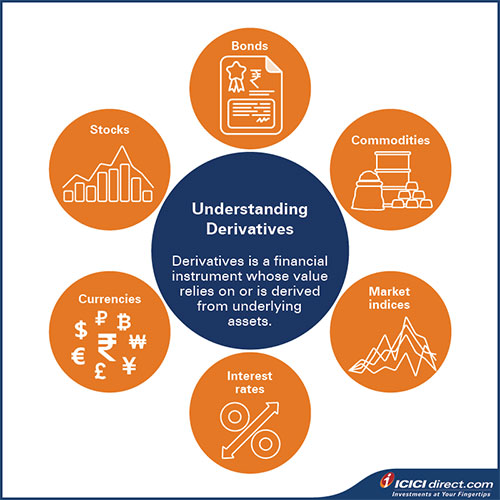Learning Modules Hide
Hide
Chapter 1: Introduction to Derivatives
When your car’s tank runs empty, you drive to the nearest petrol pump for a refuel. The electronic fuel meter displays the volume of petrol being filled, along with the amount you need to pay. You know that the price of petrol changes from time to time. Have you ever wondered how they arrive at that price?
The price you pay for petrol depends on the current price of crude oil. So, one could say that petrol has no value or worth of its own. Its value is derived from the prevailing rates for crude oil.
Similarly, a derivative is a financial instrument that has no value of its own. A derivative gets its worth or value from that of an underlying asset. The underlying assets for derivative instruments could include:
- Stocks
- Bonds
- Commodities
- Currencies
- Indices
- Interest rates
Understanding derivatives
Derivatives is a financial instrument whose value relies on or is derived from underlying assets.

Features of a derivative contract
Each time you refuel your car, there is a transaction between you (the buyer) and the petrol pump (the seller). The petrol pump sells you petrol for a specific price, and you buy the petrol at this price.
A derivative contract also involves a transaction between a buyer and a seller. Here are the key components of a derivative contract:
- Lot size or contract size stands for the number of units being exchanged. For example, a crude oil derivative may have a lot size of 100 barrels.
- The expiry date is when the derivative transaction must take place. You cannot trade the contract once the expiration date has passed.
- Price is the pre-agreed rate at which you will settle the contract
|
Did you know? The world’s first organised derivatives exchange was set up in Osaka, Japan, in 1730. The Dojima Rice Exchange witnessed some of the earliest trades. The Chicago Board of Trade was the first official commodity trading exchange in the West. Established in 1848, it initially enabled trades in wheat, corn, and soybeans through customised derivative contracts named 'Forwards'. The key objective of Forwards was to reduce the risk of price volatility among the producers and grain consumers. |
Price is the pre-agreed rate at which you will settle the contract.
How derivatives are traded
Need to buy vegetables? You could buy them directly from a farmer. The farmer is likely to give you a better price, though he may offer only a few types of vegetables. Alternatively, you could shop at the nearest supermarket. Supermarkets source their vegetables from multiple farmers, and so can provide more options. But the scope to negotiate rates and get a better deal may be limited.
You can similarly approach the trade-in derivatives. Derivative contracts are mainly of two kinds:
- Over-the-counter (OTC) derivatives are traded directly ‘over the counter’ between buyer and seller. That is the securities market equivalent of a direct transaction between you (the buyer of vegetables) and the farmer (the seller). As there is no intermediary, the two parties are free to customise the contract terms. A Forward contract is an example of an OTC derivative. We will focus more on Forward contract in the next chapter.
- Exchange-traded derivatives are bought and sold through an intermediary known as the exchange. Just as the supermarket connects you (the buyer) with vegetables from the farmer (the seller), the exchange links the buyers and sellers of derivatives. However, exchange-traded derivatives have to follow regulations set by the exchange. The contracts are therefore more standardised and offer less scope for personalisation. A Futures contract is an example of an exchange-traded derivative instrument. The following chapter will discuss more on Futures contracts.
Summary:
- Derivatives is a financial instrument that gets its value from an underlying asset such as stocks, bonds, commodities, currencies and interest rates.
- A derivative contract between a buyer and a seller contains key components such as lot size or contract size, expiry date to complete the transaction and a pre-agreed rate to settle the contract.
- Derivative contracts are mainly of two kinds -- Over-the-counter (OTC) derivatives and Exchange-traded derivatives.
Now that you've got an introduction on derivatives, we move on to Part One of the next chapter that delves into the subject of Futures and Forwards.
Disclaimer:
ICICI Securities Ltd. ( I-Sec). Registered office of I-Sec is at ICICI Securities Ltd. ICICI Venture House, Appasaheb Marathe Marg, Prabhadevi, Mumbai - 400 025, India, Tel No : 022 - 6807 7100.I-Sec acts as a Composite Corporate agent having registration number –CA0113. PFRDA registration numbers: POP no -05092018. AMFI Regn. No.: ARN-0845. We are distributors for Mutual funds and National Pension Scheme (NPS). Mutual Fund Investments are subject to market risks, read all scheme related documents carefully. Please note, Mutual Fund and NPS related services are not Exchange traded products and I-Sec is just acting as distributor to solicit these products. Please note, Insurance related services are not Exchange traded products and I-Sec is acting as a corporate agent to solicit these products. All disputes with respect to the distribution activity, would not have access to Exchange investor redressal forum or Arbitration mechanism. The contents herein above shall not be considered as an invitation or persuasion to trade or invest. I-Sec and affiliates accept no liabilities for any loss or damage of any kind arising out of any actions taken in reliance thereon. Investments in securities market are subject to market risks, read all the related documents carefully before investing. The contents herein mentioned are solely for informational and educational purpose.
 Invest
Invest







COMMENT (0)